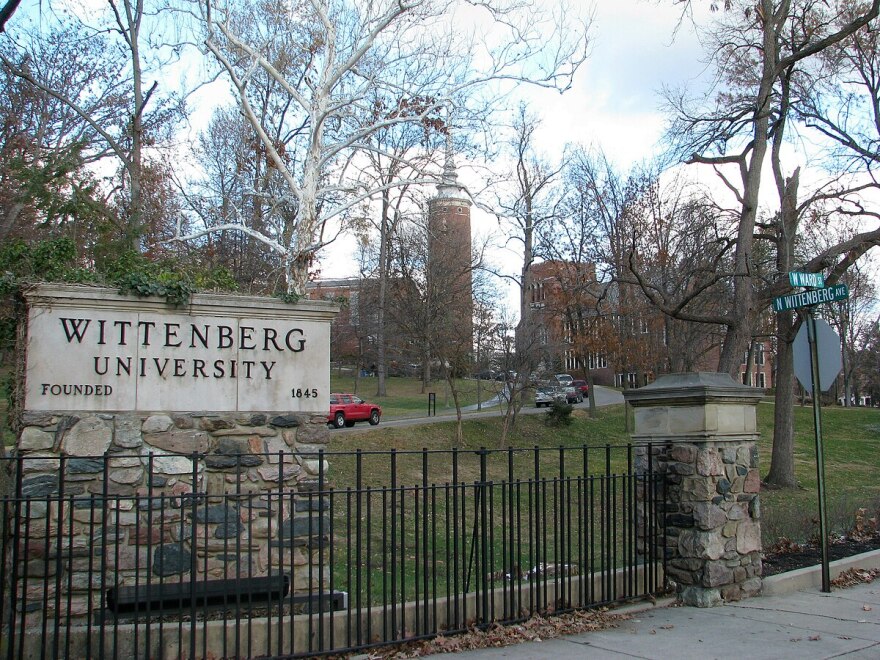Wittenberg University in Springfield is in financial distress, according to the Higher Learning Commission, a private nonprofit that accredits colleges and universities across the country.
That means it has more debt than income.
In 2023, the university owed $25 million. Since then, university president Michael Frandsen says the school has cut staff and programs to make up its shortfall.
“We eliminated Spanish and German and Chinese and we eliminated East Asian studies,” he said. “We eliminated music and music education. And we eliminated our bowling team.”
Wittenberg isn’t the only Ohio college facing financial woes.
Kathryn Mobley, education and politics reporter with WYSO in Dayton, joined the Ohio Newsroom to break down the state’s higher education landscape and explain how some universities are attempting to survive.
This conversation has been lightly edited for clarity and brevity.
On which Ohio universities are struggling financially
“In southwest Ohio, we've got Antioch College. It has an annual operating budget of more than $9 million. In 2011, a forensic audit showed the school had an $8.4 million deficit and that it was repeatedly borrowing from its endowment. Thus, the school gained fiscal distress status from the Higher Learning Commission, a private nonprofit that accredits more than 1,000 colleges and universities nationwide. It's the same group that has put Wittenberg University on fiscal distress status. The other school in southwest Ohio is Central State University. For the fiscal year 2024, it reported a deficit of $3 million. The fiscal year prior, it ran up a deficit of $14 million. So last year, the Ohio Department of Higher Education put CSU on a fiscal watch.”
On how common financial woes are in higher education
“It's becoming more common than the industry would appreciate. Best Colleges has been tracking nonprofit college and university closures and mergers since March 2020, when we were in the depths of the COVID-19 pandemic. They've discovered 42 public or private nonprofit schools or campuses have closed since that time nationwide. And 33 public or private nonprofit schools have merged with other universities.

“This year, Bluffton University in northwest Ohio was primed to close and then merge with the University of Findlay. However, that university's board of trustees voted against that merger last month. So for right now, Bluffton University is continuing to operate, but they are looking for other opportunities where they might be able to merge with a larger university to help it through this financial hardship.”
On why schools are in bad financial shape
“During the pandemic, a lot of small and medium-sized colleges and universities fell into financial trouble because people were not able to actually go to classes. Then after the pandemic, some college students decided not to go back into the classroom because they had fallen into debt since they weren't able to work for about two years, and instead they went into the workforce.
“Also what's happened across our country, more 18-year-old high school graduates are choosing to simply not go to college, but instead they're choosing to either go right into the workforce, go into the military, or they're using trade schools or trade programs. And that's in part, because they don't want to take on large college debt. Also nationally, there's a drop in social value to having a four-year degree.”
On what schools are doing to dig themselves out of debt
“Antioch right now is enacting a ‘social enterprise and enrollment plan.’ It has a lot of different layers. Part of it is putting staff and faculty on contracts to reduce some of their expenses. Also, they've closed five buildings on campus and they've sold two. They're trying to sell the rest, generating more income. Other income generators include selling parcels of land and using various campus sites as learning hubs, where they will host a program for a couple weeks or months where anyone can pay and take a class. Also this year, Antioch earned federal dollars by being a work college. Basically that means their students are required to work at least five hours a week, and then the college is paid through federal funds, and they apply that money towards the tuition of the student.
“For Central State, they have created their financial recovery plan. They're not giving a lot of details on it, but it has been approved by the Ohio Department of Higher Education — that's the state agency that has put CSU on fiscal watch. Part of that plan includes increasing fundraising.
“For Wittenberg, they're trying to generate income by creating new program partnerships with larger surrounding universities. So it’s not necessarily trying to merge with other universities, but just have collaborative programs. They are also aggressively marketing the campus for outside entertainment and conference events.”
On the future of higher education in Ohio
“In the end, Ohio will always have colleges and universities. But some of the smaller ones may have to eventually close their doors. Of the various universities I've spoken with, they are all saying this is a perfect time for them to right-size, meaning to make their campus fit the student population they actually have. And they've all said, regardless of the financial challenges they're having, they are making sure their students are still able to receive a quality education and they are very committed to not only being good stewards to their students, but also being good stewards to the communities in which they operate.”



